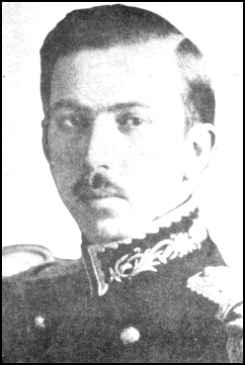
AKA GUSTAVO SALINAS CAMIÑA 1893-1964 |
 |
|
Collection of Pablo Arumbe, 8-7-09 |
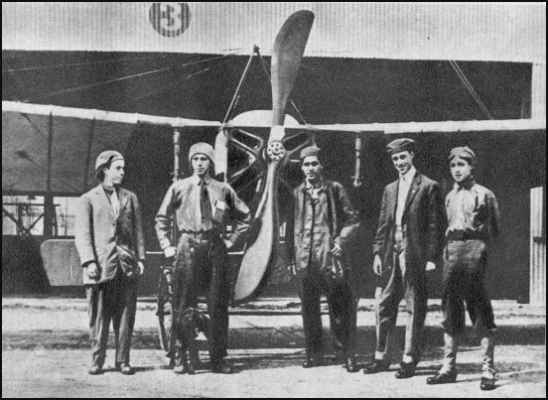 |
|
Mexico City, July, 1912. A photo for history: From left to right, Alberto Salinas Carranza, Gustavo Salinas Camiña,
Juan Pablo Aldasoro Suárez, Horacio Ruiz Gaviño and Eduardo Aldasoro Suárez. In those days, they left
for Long Island, New York, where the famous Moissant International Aviators School was established.
Ciudad de México, julio de 1912. Una foto para la historia: De izquierda a derecha, Alberto Salinas Carranza, Gustavo Salinas Camiña, Juan Pablo Aldasoro Suárez, Horacio Ruiz Gaviño y Eduardo Aldasoro Suárez. En esos dias partirian rumbo a Long Island, N. Y. , donde estaba establecida la famosa Moissant International Aviators School. Courtesy of Gerardo Garcia de León |
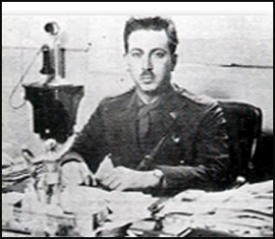 |
Fue Jefe del Departamento de Aeronáutica, impulsó la fabricación de aviones y su reparación en los Talleres Nacionales de Construcciones Aeronáuticas, teniendo una destacada actuación en la campaña de 1924. |
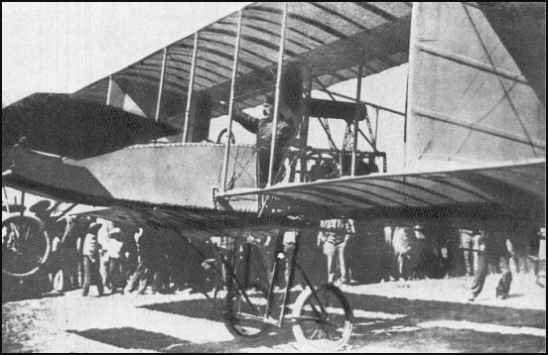 |
 |
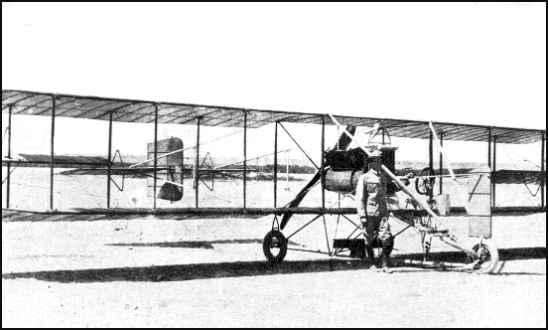 |
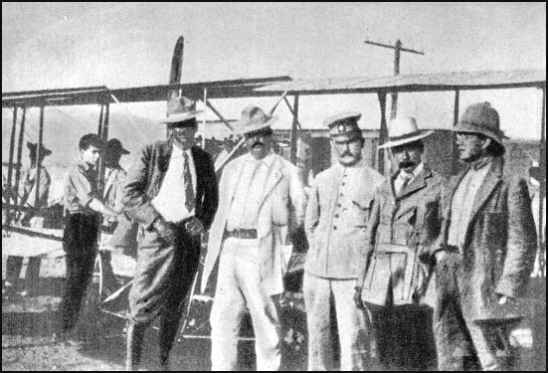 |
||
|
1910 |
1912 |
1914 |
1914 |
|
Gral. Roberto Fierro V. Extract from Revolución Mexicana / Gran Ofensiva en Occidente" Vol 45, June 1967 Courtesy of Gerardo Garcia de León It fell to the honor of Mexican Captain Gustavo Salinas Camiña to be the first man in America to use the airplane as a bomber. It occurred in 1914 in the vicinity of Topolobampo (Sinaloa). The inspiration for this event was the following: The Mexican Revolutionary Army had puts its hopes in the use of the airplane. The First Head of the Constitutionalist Army ordered Captain Camiña to buy an airplane in the United States of America. Don Venustiano Carranza assigned the plane to the column which was commanded by General Alvaro Obregón in the Northwest. The airplane was turned into a weapon of war and was ordered to carry out several bombings in the previously mentioned port on the coast of the Pacific. On several occasions, he bombed the Cañonero Guerero, forcing this Naval vessel of the Huertista regime to put out to sea each time. Tocó el honor al capitán piloto aviador mexicano, Gustavo Salinas Camiña, de ser el primer hombre que utilizó en America un avión como arma para bombardear. Fue en el curso de las acciones que tuvieron lugar en Topolobampo (Sinaloa), en el año de 1914. El antecedente de esta hechó es el siguiente: Existía el anhelo de que el Ejército de la Revolución contara con aeroplanos. Ese afán se hizo realidad cuando el Primer Jefe del Ejército Constitucionalista ordenó al mencionado piloto, que comprara en los Estados Unidos de Norteamérica un avión. Don Venustiano Carranza entregó el aparato a la columna que el general Alvaro Obregón mandava en el Noroeste, y a ese avión le tocó en suerte convertir a la aviación en arma de guerra, al efectuar varios bombardeos aéreos en el antedicho puerto de la costa del Pacífico. Dejó caer en varias ocasiones su carga de bombas sobre el cañonero. Guerero, de la marina de guerra adicta el régimen huertista, obligándolo a retirarse en cada ocasion mar afuera. Courtesy of Gerardo Garcia de León |
 |
| MEXICAN AIR CHIEF AT MAXWELL --Making a nation-wide tour of Army Air Forces stations, Maj. Gen. Gustavo Salinas (left), head of the Mexican Air Forces, visits Maxwell Field and is honored by a parade of aviation cadets. With him are Col. Elmer J. Bowling, Maxwell Field commanding officer (center), and Col. D. D. Fitz Gerald, chief of staff, AAFSETC |
|
In Allied Air Power NEWS Montgomery Alabama, Saturday, August 14, 1943 Fought With Villa In Revolution, Using Home-Made Bombs That is the opinion of Mar. Gen. Gustavo Salinas, chief of the Mexican Army Air Forces, who arrived this week at Maxwell, for an inspection of training facilities on this post and elsewhere in this Southeast Training Center. General Salinas should know of what he speaks, for he is one of the pioneers in the field of military aviation. During his visit the general reminisced concerning his first bombing exploits, back in 1913-144, when he was participating with Villa in the Mexican Revolution. "The bombs I used were home-made," he declared, "with a charge of 52 sticks of dynamite. Primitive as they were, they worked like a charm. At the time I was flying an old Wright pusher type. It occurred to me that the day would come when we would have planes of weight-carrying efficiency beyond one's fondest hopes, and that then the plane would come into its own as a military assault weapon of fabulous power. That day has come." Speaking faultless English, black-haired, but graying at the temples, the chief of the Mexican Army Air Forces went on to speak of his trip of inspection. He pointed out that the primary, basic and advanced training system utilized by the A.A.F. Training Command in training its pilots, is being reproduced in Mexico. He said that the center of his country's training program was being shifted to Guadalajara, because of the more desirable altitude and climate. Accompanied by his aide, Capt. Radames Gaxiola, General Salinas came to the Training Center on the invitation of Marj. Gen Thomas J. Hanley, Jr., commanding the AAAFSETC, whom he met in a conference at Fr. Worth with Maj. Gen. Barton K. Yount, the commanding general of the AAF Training Command. General Salinas inspected Maxwell Field's Liberator bomber pilot school and the preflight school. He also inspected training facilities at Gunter Field. He will return to Mexico upon completion of his tour. Escorting him on the inspection tour are Col Arthur W. Brock, Jr., deputy chief of Air Staff, Intelligence, Washington, D. C.; Maj. David M. Warner, of the Materials Laboratory, Engineering Division, Wright Field, Dayton, Ohio; and Maj. G. T. McHugh, of Headquarters, AAF, Plans Air Staff, and the Joint Mexico-U. S. Commission of the War Department, in Washington, D. C. Speaking of the training program of the AAF, General Salinas declared: "We are following it fairly closely, since the United States has had a good deal of experience in developing the program over a period of years, there is no reason why we should attempt to do something different." General Salinas received his first commercial license -- the coveted early number 172 -- from the Aero Club of America at Flushing Meadows, N. Y., not far from the present Mitchell Field, back in 1912. Educated in San Antonio, Texas, and at Manilus, N. Y., he received his degree in Engineering from Renssalaer Polytechnic Institute, N. Y........ |
"In the early years of the twentieth century, the nature of warfare changed dramatically. The deployment of aircraft unleashed a powerful new weapon for warring factions, previously forced to rely only on their land and sea forces." After recounting the events which preceeded this crucial development in Naval warfare, Tony describes in great detail the role which Gustavo Salinas played as follows: "In April 1914, one of Obregón's gunships, the Tampico, was sailing off the coast of Sinaloa, close to the port of Topolobampo (near Los Mochis), when it came under attack from two Huertista warships: the Morelos and the Guerrero. Obregón ordered Gustavo Salinas Camiña to do something about it. On April 14, accompanied by his mechanic Teodoro Madariaga, Salinas flew Sonora, his Glenn Martin pusher biplane, overhead and began bombing the Guerrero. The Huertista warships put out to sea, and the Tampico survived to fight another day. Two months later, however, when the Tampico met up with the Guerrero again, it was less lucky. On that occasion, it caught fire and sank." You can enjoy the entire exciting story by clicking on the title above. |
If you need an English translation, you can use the extract which follows: |
| The early development of aviation awakened the interest of individuals and of the Government of the Mexican Republic. On November 30, 1911, President Francisco I. Madero flew in a " Deperdussin " airplane, thus becoming the first Chief of State in the World to fly. | 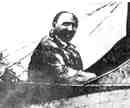 |
| President Madero was convinced of the important role which airplanes could play in war when serving as the " eyes of the Army ", He bought several and established scholarships which enabled five Mexicans to receive flight training abroad. Those pioneers of military aviation in Mexico were: Alberto Salinas Carranza, Gustavo Salinas Camiña, Horacio Ruiz Gabiño and the brothers, Juan Pablo Aldasoro Suárez and Eduardo Aldasoro Suárez. |
|
NATIONAL AVIATION DAY (DIA NACIONAL DE LA AVIACION) It was in the nineteenth century that the design of vehicles "to establish records of altitude, speed, et cetera" began, although not exclusively with airplanes. In 1908, Alfredo Robles Domínguez published the book Tratado de locomoción aérea. (Treatise of Aerial Locomotion). |
|
In 1909, the la Sociedad Impulsora de la Aviación,
(Impelling Society of Aviation), was established and on January 8, 1910, on the plains of Balbuena, Alberto Braniff successfully made
the first flight in a Voisin biplane powered by a 60 horsepower engine. With the ability to control the direction of flight, he flew a distance
of500 meters at a height of 25 meters. Just a short time later, Braniff and some of his friends founded the
Club Aéreo de la Ciudad de México.(Aerial Club of the City of Mexico). During the Maderista government, the acrobatic group of the Moissant International Aviators arrived at Mexico, to give an aerial exhibition. Upon seeing this, Francisco I. Madero decided to buy five airplanes and to grant scholarships in Long Island, New York to the first Mexican pilots: Alberto Salinas Carranza, Gustavo Salinas Camiña, Horacio Ruiz Gaviño and the Juan Pablo and Eduardo Aldasoro Suárez brothers. August 3, 1912, Miguel Lebrija flew to an altitude of 300 meters over the Valley of Mexico, being the first Mexican to fly on the metropolitan cathedral. After " the tragic ten ", in February of 1913, General Alvaro Obregón ordered the purchase of two airplanes, to use as bombers in Guaymas, Sonana. In 1914, Gustavo Salinas Camiña, bombed to the Guerrero cannoneer , thus establishing a new use to the airship. |
|
fragment from Revolución Mexicana / Contrarrevolución en Yucatan" Vol 61, October 1967 Courtesy of Gerardo Garcia de León Meanwhile, Alberto Salinas with a degree of lieutenant , was commisioned by the First Headquarters of the Constitutionalist Government, to go to Chihuahua under the orders of general Francisco Villa. Previously and upon the initiative of the aforementioned official, Gustavo Salinas, they had been assigmed to the Moissant International School, three airplanes of the last Moraine-Saulnier model, that were to be delivered to the border town of Juárez City. Also the services of Mr. Francisco Santarini were contracted, to be in charge of the maintenance of the machines. The purpose that perseguia with the use of these airplanes, was the one to gain a fast victory in marks to Tower by the forces to the orders of general Villa: having itself taken nevertheless his construction, more time of the anticipated one, it was necessary to do without them during that memorable feat of arms Mientras tanto, Alberto Salinas, con el grado de teniente, fue comisonado por la Primera Jefatura del Gobierno Constitucionalista, para pasar a Chihuahua a las órdenes del general Francisco Villa. Con anteroridad y por iniciativa del citado oficial Gustavo Salinas, se habían pedido a la Moissant International School, tres aviones del último modelo Moraine-Saulnier, que deberia ser entregados en la población fronteriza de Ciudad Juárez. Asimismo se contrataron los servicios del señor Francisco Santarini, para que se hiciera cargo del mantenimiento de dichas máquinas. La finalidad que se perseguia con el empleo de estos aviones, era la de obtener una rápida victoria en el taque a Torreón por las fuerzas a las órdenes del general Villa: habiéndose tardado sin embargo su construcción, más tiempo del previsto, hubo que prescindir de ellos durante ese memorable hecho de armas. The flotilla did not arrive to engage in battle, that is not in an armed effort against the forces of the usurper Victoriano Huerta. Because of the insubordination of General Villa to the Constitutionalist Government, the flotilla did not follow his orders, being rather under the direct control of the First Headquarters of the Constitutionalist Government, responsible to the Secretary of the Army and Navy. The flotilla performed magnificently in the Yucatan Peninsula and the action of Ebano, Tamaulipas, the year of 1915. Esta flotilla no llegó s entrar en acción, en ningún hecho de armas, contra las fuerzas del usurpador Victoriano Huerta. Por la insubordinación del general Villa al Gobierno Constitucionalista, esta flotilla no pasó a depender de dicho jefe, quedando a las órdenes directas de la Primera Jefatura del Gobierno Constitucionalista, dependiente de la Secretaria de Guerra y Marina. Esta flotilla tuvo una magnifica actuación en la peninsula de Yucatán y en los combates de el Ebano, en Tamaulipas, en el año de 1915. |
 |
|
HE WAS CALLED BEFORE GOD'S TRIBUNAL DIVISION GENERAL GUSTAVO A. SALINAS CAMIÑA REST IN PEACE As you might notice there's inconsistency (1 day) in the date of his death. Photo courtesy of Luis García de León, 7-12-04 |
|
"Luis García de León, sends the following information to us: Looking for information for my genealogical tree I found your page. I thought that great-grandfather QEPD would be to you of utility information on the death of Gustavo Adolpho Salinas Camiña -. He died the 5th of March of 1964, at the age of 70 years. He was buried in the Municipal Pantheon San José located in Villa de Cuatro Ciénegas de Carranza, Coahuila, México." Editor's Note: This information came from Cosme Alvarez Cabañes' website, La Web del Factor Humano en la Aviación. The website was recommended to me by Angel Martini of Buenos Aires and proves to be a really remarkable resource. It is written entirely in Spanish, which limits it usefullness to those of us who can only read English, but does suggest the wealth of material which is available on the internet in other languages. If time permits, I recommend that you take advantage of one of the machine-translation programs, Babel Fish or Systran, to translate it into English. |
|
If you have any more information on this Early Flier, please contact me. E-mail to Ralph Cooper Back 

|